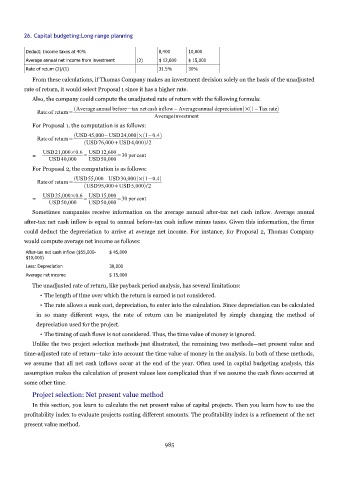Page 984 - Accounting Principles (A Business Perspective)
P. 984
26. Capital budgeting:Long-range planning
Deduct: Income taxes at 40% 8,400 10,000
Average annual net income from investment (2) $ 12,600 $ 15,000
Rate of return (2)/(1) 31.5% 30%
From these calculations, if Thomas Company makes an investment decision solely on the basis of the unadjusted
rate of return, it would select Proposal 1 since it has a higher rate.
Also, the company could compute the unadjusted rate of return with the following formula:
Average annual before−tax netcash inflow – Averageannual depreciation×1 – Tax rate
Rateof return=
Averageinvestment
For Proposal 1, the computation is as follows:
USD 45,000– USD24,000×1– 0.4
Rateof return=
USD76,000USD4,000/2
USD21,000×0.6 USD12,600
= = =30 per cent
USD40,000 USD50,000
For Proposal 2, the computation is as follows:
USD55,000 – USD30,000×1−0.4
Rateof return=
USD95,000USD5,000/2
USD25,000×0.6 USD15,000
= = =30 per cent
USD50,000 USD50,000
Sometimes companies receive information on the average annual after-tax net cash inflow. Average annual
after-tax net cash inflow is equal to annual before-tax cash inflow minus taxes. Given this information, the firms
could deduct the depreciation to arrive at average net income. For instance, for Proposal 2, Thomas Company
would compute average net income as follows:
After-tax net cash inflow ($55,000- $ 45,000
$10,000)
Less: Depreciation 30,000
Average net income $ 15,000
The unadjusted rate of return, like payback period analysis, has several limitations:
• The length of time over which the return is earned is not considered.
• The rate allows a sunk cost, depreciation, to enter into the calculation. Since depreciation can be calculated
in so many different ways, the rate of return can be manipulated by simply changing the method of
depreciation used for the project.
• The timing of cash flows is not considered. Thus, the time value of money is ignored.
Unlike the two project selection methods just illustrated, the remaining two methods—net present value and
time-adjusted rate of return—take into account the time value of money in the analysis. In both of these methods,
we assume that all net cash inflows occur at the end of the year. Often used in capital budgeting analysis, this
assumption makes the calculation of present values less complicated than if we assume the cash flows occurred at
some other time.
Project selection: Net present value method
In this section, you learn to calculate the net present value of capital projects. Then you learn how to use the
profitability index to evaluate projects costing different amounts. The profitability index is a refinement of the net
present value method.
985

